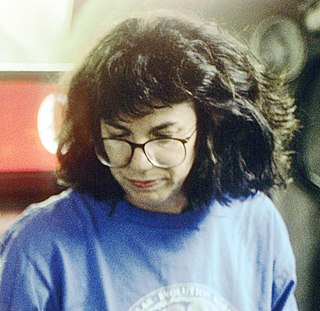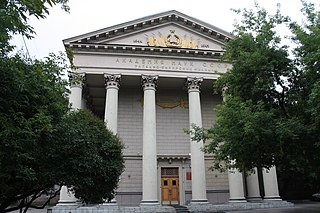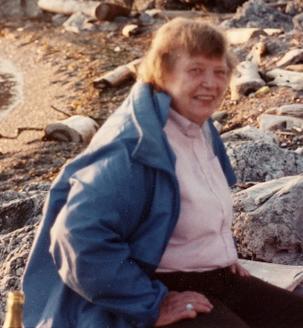
The Marine Biological Laboratory (MBL) is an international center for research and education in biological and environmental science. Founded in Woods Hole, Massachusetts, in 1888, the MBL is a private, nonprofit institution that was independent for most of its history, but became officially affiliated with the University of Chicago on July 1, 2013. It also collaborates with numerous other institutions.
The Rosenstiel School of Marine, Atmospheric, and Earth Science is the University of Miami's academic and research institution for the study of oceanography, atmospheric, and earth sciences.
Hopkins Marine Station is the marine laboratory of Stanford University. It is located ninety miles south of the university's main campus, in Pacific Grove, California on the Monterey Peninsula, adjacent to the Monterey Bay Aquarium. It is home to ten research laboratories and a fluctuating population of graduate and undergraduate students. It has also been used for archaeological exploration, including of the Chinese-American fishing village that existed on the site before burning down in 1906.
Richard Randolph "Randy" Olson is a marine biologist-turned-filmmaker who earned his Ph.D. in Biology from Harvard University (1984) and became a tenured professor of marine biology at the University of New Hampshire (1992) before changing careers by moving to Hollywood and entering film school at the University of Southern California.

The Oregon Institute of Marine Biology is the marine station of the University of Oregon. This 100-acre (0.40 km2) marine station is located in Charleston, Oregon at the mouth of Coos Bay. Currently, OIMB is home to several permanent faculty members and a number of graduate students. OIMB is a member of the National Association of Marine Laboratories (NAML). In addition to graduate research, undergraduate classes are offered year round, including marine birds and mammals, estuarine biology, marine ecology, invertebrate zoology, molecular biology, biology of fishes, biological oceanography, and embryology.
The Carnegie Institution of Washington, known also for public purposes as the Carnegie Institution for Science (CIS), is an organization in the United States established to fund and perform scientific research. The institution is headquartered in Washington, D.C. As of June 30, 2020, the Institution's endowment was valued at $926.9 million. In 2018 the expenses for scientific programs and administration were $96.6 million. Eric Isaacs is president of the institution.

Colleen Marie Cavanaugh is an American academic microbiologist best known for her studies of hydrothermal vent ecosystems. As of 2002, she is the Edward C. Jeffrey Professor of Biology in the Department of Organismic and Evolutionary Biology at Harvard University and is affiliated with the Marine Biological Laboratory and the Woods Hole Oceanographic Institution. Cavanaugh was the first to propose that the deep-sea giant tube worm, Riftia pachyptila, obtains its food from bacteria living within its cells, an insight which she had as a graduate student at Harvard. Significantly, she made the connection that these chemoautotrophic bacteria were able to play this role through their use of chemosynthesis, the biological oxidation of inorganic compounds to synthesize organic matter from very simple carbon-containing molecules, thus allowing organisms such as the bacteria to exist in deep ocean without sunlight.
Mimi A. R. Koehl is an American marine biologist, biomechanist, and professor at University of California, Berkeley, and head of the Koehl Lab. She was a MacArthur Fellow in 1990.
Robert Treat "Bob" Paine III was an American ecologist who spent most of his career at the University of Washington. Paine coined the keystone species concept to explain the relationship between Pisaster ochraceus, a species of starfish, and Mytilus californianus, a species of mussel.
John Edward Morton was a biologist, scholar, theologian, and conservationist from New Zealand. Trained at Auckland University College and the University of London, he became the author of numerous books, papers, and newspaper columns. Morton researched New Zealand's ecology and marine life, and was a marine zoologist. He was also the presenter of the imported nature and science television programme, Our World.
Anne Catherine Hof Blinks (1903–1995) was an American botanist and textiles scholar.

Trevor Kincaid was a Canadian-American scientist and professor at the University of Washington who achieved national acclaim for his scientific achievements while an undergraduate student. Kincaid's interests ranged from insect life to marine biology to mollusks, though he once described himself as an "omniologist". He is best known for introducing the gypsy moth parasite to the United States, for helping establish the Washington state oyster industry, and as the driving force behind the creation of the Friday Harbor Laboratories. Kincaid is responsible for the identification and naming of hundreds of species; at least 47 plant and animal species were, in turn, named after him. In 1938 he was designated Alumnus Summa Laude Dignatus of the University of Washington, that school's highest honor for its alumni.

The Institute of Systematics and Ecology of Animals (ISEA) located in Novosibirsk is one of the oldest research organization in the Siberian Branch of the Russian Academy of Sciences. The institute was founded in 1944 as Biomedical Institute, the first Siberian academic establishment working in biology. The Siberian Zoological Museum of the ISEA SB RAS has the third-largest coleopteran collection in Russia. Some Siberian research organizations as the Central Siberian Botanical Garden SB RAS and the Institute of Soil Science and Agricultural Chemistry SB RAS were derived from the Institute former laboratories.

Patricia Louise (Pat) Dudley (1929–2004) was an American zoologist specializing in research of copepods. An early pioneer using an electron microscope to study copepod organs and tissues, she taught at Barnard College for 35 years and served as Chair of the Biological Sciences department. Dudley was a National Science Foundation faculty fellow. She donated funds to establish the Patricia L. Dudley Endowment at Friday Harbor Labs, where she conducted research.
Helen Riaboff Whiteley (1921–1990) was a microbiologist who spent most of her research career at the University of Washington.
Arthur Henry Whiteley (1916-2013) was a zoologist who spent most of his research career at the University of Washington, where he studied developmental biology using sea urchins as a model organism.

Nancy Helen Marcus was an American biologist and oceanographer. During her graduate studies, Marcus became known as an expert on copepod ecology and evolutionary biology. She began her career as a postdoctoral fellow at the Woods Hole Oceanographic Institution where she studied copepod dormancy and its implications for marine aquaculture. She continued her field research as a professor of oceanography and later as the director of the Florida State University Marine Laboratory (FSU). During this time Marcus was elected as a Fellow of the Association for Women in Science and the American Association for the Advancement of Science and served as the president of the Association for the Sciences of Limnology and Oceanography. As the president, she led efforts in increase education activities and to increase the endowment fund.
Lynn Moorhead Riddiford is an American entomologist and developmental biologist. She was the first female faculty member in the Harvard Biology Department where she served as an assistant and associate professor. She is an emeritus professor at the University of Washington. In 1997, she was the first awardee of the Recognition Award in Insect Physiology, Biochemistry, and Toxicology from the Entomological Society of America. Riddiford studies the endocrinology of insects, specifically the tobacco hornworm.
Billie J. Swalla is a professor of biology at the University of Washington. She was the first female director of Friday Harbor Laboratories, where she worked from 2012 to 2019. Her lab investigates the evolution of chordates by comparative genetic and phylogenetic analysis of animal taxa.










